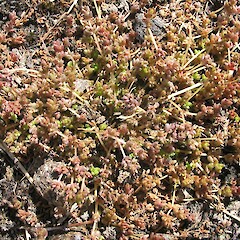Crassula mataikona
Synonyms
Tillaea debilis Colenso ex Hook.f.
Family
Crassulaceae
Flora category
Vascular – Native
Endemic taxon
Yes
Endemic genus
No
Endemic family
No
Structural class
Herbs - Dicotyledons other than Composites
NVS code
The National Vegetation Survey (NVS) Databank is a physical archive and electronic databank containing records of over 94,000 vegetation survey plots - including data from over 19,000 permanent plots. NVS maintains a standard set of species code abbreviations that correspond to standard scientific plant names from the Ngä Tipu o Aotearoa - New Zealand Plants database.
CRAMAT
Current conservation status
The conservation status of all known New Zealand vascular plant taxa at the rank of species and below were reassessed in 2017 using the New Zealand Threat Classification System (NZTCS) – more information about this can be found on the NZTCS website. This report includes a statistical summary and brief notes on changes since 2012 and replaces all previous NZTCS lists for vascular plants.
Please note, threat classifications are often suggested by authors when publications fall between NZTCS assessment periods – an interim threat classification status has not been assessed by the NZTCS panel.
- Conservation status of New Zealand indigenous vascular plants, 2017 . 2018. Peter J. de Lange, Jeremy R. Rolfe, John W. Barkla, Shannel P. Courtney, Paul D. Champion, Leon R. Perrie, Sarah M. Beadel, Kerry A. Ford, Ilse Breitwieser, Ines Schönberger, Rowan Hindmarsh-Walls, Peter B. Heenan and Kate Ladley. Department of Conservation. Source: NZTCS and licensed by DOC for reuse under the Creative Commons Attribution 4.0 International licence.
2017 | At Risk – Naturally Uncommon | Qualifiers: DP, Sp
Previous conservation statuses
2012 | At Risk – Naturally Uncommon | Qualifiers: Sp
2009 | At Risk – Naturally Uncommon
2004 | Data Deficient
Distribution
Endemic. New Zealand: North Island (Awakino and South Taranaki Coastline, coastal eastern Wairarapa, Aorangi Range, Cape Palliser, and Wellington coastlines), South (Marlborough Sounds, and parts of the eastern South Island coastline as far south as Dunedin, and also known from several sites in inland central Otago). Also reported as a weed in Christchurch and Dunedin bowling greens.
Habitat
A coastal species of open ground, often amongst Zoysia-dominated turf. It will not tolerate tall vegetation, and requires frequent disturbance to keep the habitats it frequents sparsely-vegetated.
Detailed description
Short-lived succulent, moss-like, herb forming diffuse clumps. The fleshy trailing stems are white or white tinged pink, and root freely at the nodes. Leaves pale green to pink (in exposed, stressed plants) fused at base, 1.3-3 × 1-1.5 mm, 0.8 mm thick, ovate-elliptic, flattened above, convex beneath; apex rounded or subacute. Flowers solitary in leaf axils, minute, 1.2-1.8 mm diameter, with 4 petals. Petals greenish with pink tips, often obscured by subtending calyx lobes. Mature fruits minute. Seeds black 0.4 mm long.
Similar taxa
Distinguished from C. manaia by its greater size, tendency to form diffuse clumps, with the pale stems obvious between leaf clusters, and by its larger flowers and seeds. Distinguished from C. sieberiana and C. colligata by its smaller, moss-like, decumbent habit, with the stems scarcely erect, trailing or arching over the ground, and by the flowers solitary in the leaf axils. Introduced species C. colorata var. acuminata and C. alata might also be confused with it.
Flowering
Flowering has been observed throughout the year.
Flower colours
Green, Red/Pink
Fruiting
Fruiting plants may be found throughout the year.
Life cycle
Minute follicles are dispersed by wind and water and possiblty also by attachment (Thorsen et al., 2009).
Propagation technique
Very easily grown from small rooted pieces or seed. Although plants grow quickly they are prone to being invaded and smothered by other more aggressive weeds, such as Cardamine spp. or Oxalis spp.
Threats
The habitats it occupies are frequented by introduced weeds. Because it is so small, C. mataikona is easily over-looked, and so has been rarely collected. It is easily confused with seedling C. sieberiana or C. colligata (two species with which it often grows), or even the much smaller C. manaia. As a result of the potential for these misidentifications some C. mataikona populations have gone unrecognised until recently. It is such incidental discoveries as these which suggest C. mataikona might be more common than previously believed.
Etymology
crassula: From the Latin crassus ‘thick’, meaning ‘rather thick’
Attribution
Fact sheet prepared for NZPCN by P.J. de Lange (1 November 2005). Description adapted from Allan (1961) and Webb et al. (1988), supplemented with observations made from fresh and dried material.
References and further reading
Allan, H.H. 1961: Flora of New Zealand. Vol. I. Wellington, Government Printer.
Thorsen, M.J.; Dickinson, K.J.M.; Seddon, P.J. 2009: Seed dispersal systems in the New Zealand flora. Perspectives in Plant Ecology, Evolution and Systematics 11: 285-309.
Webb, C.J.; Sykes, W.R.; Garnock-Jones, P.J. 1988: Flora of New Zealand. Vol. IV. Naturalised Pteridophytes, Gymnosperms, Dicotyledons.Christchurch, New Zealand, Botany Division, D.S.I.R..
NZPCN Fact Sheet citation
Please cite as: de Lange, P.J. (Year at time of access): Crassula mataikona Fact Sheet (content continuously updated). New Zealand Plant Conservation Network. https://www.nzpcn.org.nz/flora/species/crassula-mataikona/ (Date website was queried)















